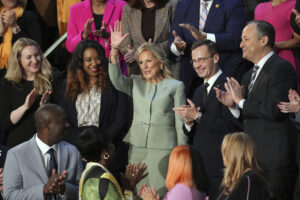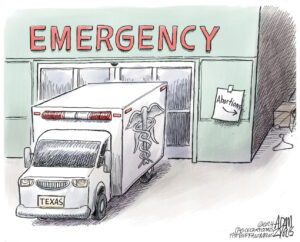Endangering Choice
While gay marriage is losing its stigma, abortion is once again retreating to the closet.NEW HAVEN, Conn. — Do you remember the New Yorker cartoon showing a couple in their living room reading the newspaper? “Gays and lesbians getting married,” reports the husband to his wife, whereupon he adds, “haven’t they suffered enough?”
This was an arch and ironic commentary on the image of a beleaguered minority actually trying to break into an institution.
Last week it happened again. Connecticut became the third state, after Massachusetts and California, to let homosexuals break into the institution of marriage. The Connecticut Supreme Court ruled that even in a state with civil unions, separate wasn’t equal. Anything less than marriage violated equal protection laws.
This ruling was greeted with cheers from couples who had sued for the right to marry. Among them were the two women, mothers of adopted twins, and two men, one of whom proclaimed cheerily, “We can now register at Home Depot and prepare for marriage.”
I am fully aware that same-sex marriage is a polarizing issue and an engine for backlash. It’s back on the ballot in three states this November, including California, where couples are rushing to the altar before they can be de-married. But Connecticut is a good reminder of how fast attitudes toward gay rights have changed. And how fast the public image of gays has gone from San Francisco flamboyance to suburban sobriety. The fear-mongering of the “Gay Agenda” is now the wedding registry at Home Depot.
When the Connecticut decision came down, I was at a Yale Law School conference on “The Future of Sexual and Reproductive Rights.” Here academics and activists were talking about gay rights and abortion as law, and as tools for the culture-war recruiters.
Stanford law professor Pam Karlan was the first to compare changes in the last two decades. “Gays have come out of the closet,” she said, “and women who’ve had abortions have gone back into the closet.”
The long slow process of “coming out” means that today nearly everyone knows someone who is gay. Gays are no longer some foreign “them,” especially to younger Americans who are four times more likely than their grandparents to support marriage equality. Even Sarah Palin painted herself “tolerant” during the vice presidential debate and talked about her “diverse” friends and family.
The long slow process of “going back in” has meant, in Karlan’s words, that “we don’t always know that we know someone who’s had an abortion.” Has the invisibility of these women made it easier to chip away at their rights?
This change has happened in public as well as private. In 1989, television’s “thirtysomething” was boycotted for a single gay scene. Today, as Yale historian George Chauncey says, “There are many sympathetic gay characters on TV and the movies.” But he adds, “almost no sympathetic characters who are getting abortions.” Hollywood’s heroines from “Juno” to “Waitress” to “Knocked Up” barely think about it.
The analogy is far from perfect, as I will hear from every pro-life reader who equates abortion with murder. And it’s been a long time, thankfully, since we read stories of victims of illegal abortion. To the degree that the gay rights movement has focused on marriage, it’s seen as intrinsically conservative, even pro-family. On the other hand, an abstract set of abortion rights is framed as an individual choice.
Moreover, the narrative of same-sex marriage ends with the sound of a champagne bottle popping at a wedding. An abortion, on the other hand, may be followed by an assortment of emotions, but certainly not joy.
Because we rarely see real women, it’s easy to forget that one out of every three American women has had an abortion by the time she’s 45. As Karlan said, “Look to your right. Look to your left. One of you has had an abortion.” Because we rarely hear from women, it’s easy to forget that over half those women already have children and are making their decisions in that family context.
Abortion was legalized on the grounds of the right to privacy. And so it remains private. But the more private it is, the more we think it only happens to someone else, someone “unlike us.” The more unlike us she is, the less public support there is for the right. Abortion rights slip away as the woman slips out of sight.
Here is the conundrum in the closet. For all the lingering opposition to same-sex marriage, being gay is losing its stigma. Having an abortion is being more deeply stigmatized.
Look to your right. Look to your left.
Ellen Goodman’s e-mail address is ellengoodman(at)globe.com.
© 2008, Washington Post Writers Group
Your support matters…Independent journalism is under threat and overshadowed by heavily funded mainstream media.
You can help level the playing field. Become a member.
Your tax-deductible contribution keeps us digging beneath the headlines to give you thought-provoking, investigative reporting and analysis that unearths what's really happening- without compromise.
Give today to support our courageous, independent journalists.






You need to be a supporter to comment.
There are currently no responses to this article.
Be the first to respond.